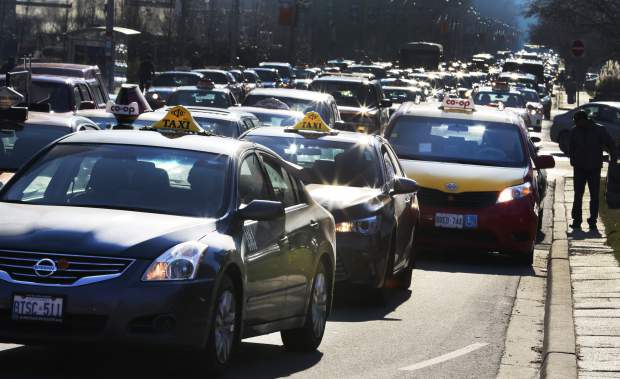By Liam Fox
On December 9th, taxi drivers from across Toronto staged a series of protests against the rival company Uber. Protesters shut down four high traffic areas before finishing with a demonstration at City Hall, calling upon the mayor to ‘bring justice’ to drivers by stopping Uber from operating illegally. These disruptions reverberated throughout the city as thousands of commuter vehicles came to a resounding halt.
Uber is a company that uses online software to connect customers to drivers, often for much cheaper than what many licensced taxi competitors offer. Since Uber’s conception in Silicon Valley only a few years ago, it has spread to cities across the world—much to the dismay and protest of local taxi drivers. Both the Uber company and its software seem to represent where capitalism is headed right now. Many companies like Uber are moving toward a model in which they focus on the delivery of goods and services as efficiently as possible to middle class consumers using a combination of cutting edge technology and easily exploitable and disposable workers who are conveniently labelled independent contractors. The broader ‘Uberization’ of the economy is already underway, as the Uber platform is now being used from everything from package deliveries, to health care, to snow removal.
In Toronto during the December 9 th strike, drivers pointed out that Uber drivers don’t pay licensing fees and undergo minimal training. As the Ontario Highway Traffic Act makes it illegal for any taxis to operate without special licensing, drivers questioned why city officials had yet to impose any restrictions on Uber operations. Mayor John Tory had indicated on several occasions that such plans were in the works, yet none had materialized.
In their protest, taxi drivers staged city hall demonstrations, road blocks, and a hunger strike. Frustrations were clearly running high: in one widely circulated video, a taxi driver was dragged down Queens Park Crescent by an Uber car; in another, a driver compared Uber to ISIS. Still, the sentiment of the protest is relatable.
Uber receives an unfair business advantage due to lack of regulation, and its introduction to Toronto has brought dramatic changes to the lives of already poorly paid taxi drivers—more than 80% of whom are working class immigrants. It is not uncommon for taxi drivers to have seen their incomes halved since the advent of Uber. “I’ve been a taxi driver for 25 years,” said one driver from Scarborough, “and this is the biggest change I’ve seen in my income over the shortest amount of time.”
Uber drivers have fared no better. Many were tempted by the flexibility of owning their own business and scheduling their own hours—something that the company advertises as a key selling point. Uber calls its drivers ‘business partners,’ only requiring them to have access to a car and a license, making it a highly accessible low-skilled job. As economic opportunities are scarce enough for those at the bottom, it’s not surprising to learn that many Uber drivers—especially those who drive for the lower-class ‘UberX’, and especially those who rely on Uber for most of their income—are working class immigrants who live in Toronto’s suburbs.
Since Uber cut its prices in 2014, many drivers now claim to work much longer hours and still struggle to make minimum wage from their fares. Even though drivers own their cars and pay for car insurance, gas, repairs, and so on, Uber still pockets 20% of their income as an access fee to the market of transporting people.
Uber drivers also depend on their customer satisfaction star-ratings, and rarely speak frankly about the conditions of their exploitation. For example, if they hold an average rating of less than 4.7 (out of 5) in many cities, they can be fired. Uber drivers have begun to organize in parts of the USA, demanding fairer working conditions and a living wage.
Parallels can easily be drawn between exploitation of both taxi drivers and Uber drivers by their respective employers. All drivers are faced with the burden of paying for the maintenance of their own vehicles. They also face daily, sometimes violent, racism. The companies that employ these drivers refuse to raise their wages, even as their livelihoods are threatened by economic insecurity. All are working longer hours and even taking on other jobs to make ends meet. Importantly, so many drivers are immigrants who came to Canada, the so-called land of economic opportunity, only to find themselves racialized and forced into cheap labour markets.
There is no doubt that the Uber corporation is worthy of contempt. Nevertheless, something missing from the recent taxi strike was a working class perspective. By directing complaint at the illegality of Uber, the protests missed the point that taxi drivers and many Uber drivers actually share a common struggle. It also shifts responsibility away from the exploitative taxi companies who continue to profit from their drivers’ labour.
Still, in the so-called Uberizing economy taxi and Uber drivers alike should take stock of the incredible power they sit on, as demonstrated by the traffic-blocking protests. In Toronto, a city where business demands the fast-moving uninterrupted flow of people and goods, taxis (and Ubers) are a vital part of the transportation infrastructure. Organizing a city-wide shutdown is undoubtedly a useful way to make one’s voice heard.
Featured image from The National Post
Comments
